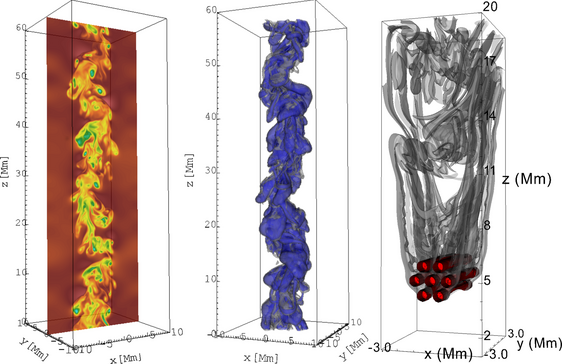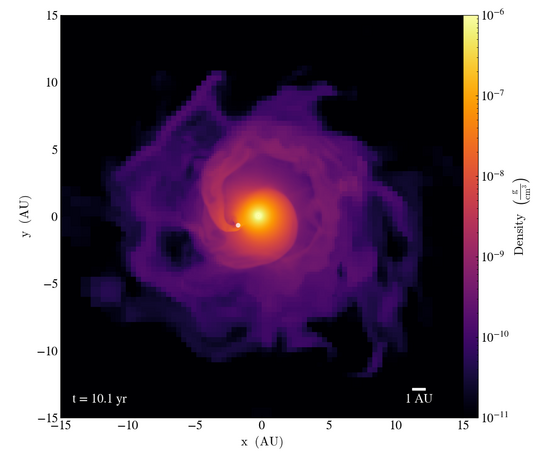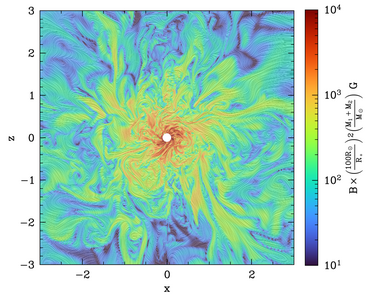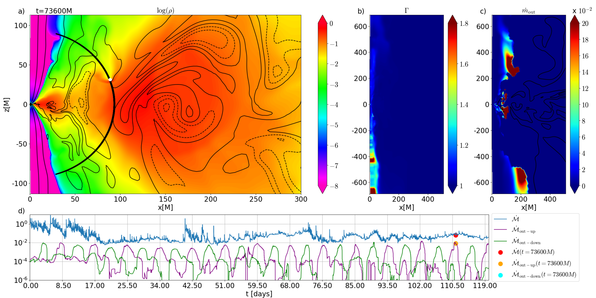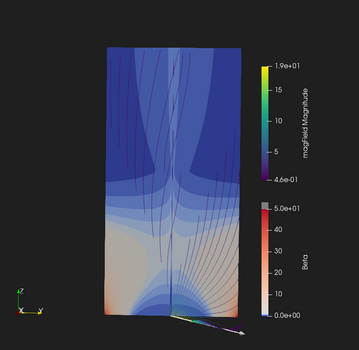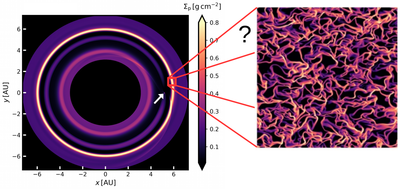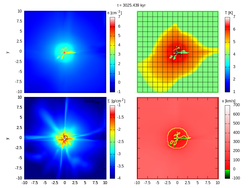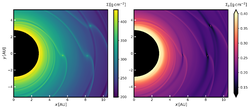Dynamics of the Solar Corona in the Era of Data Intensive Observation
Call: 32nd Open Access Grant Competition; OPEN-32-57
Researcher: Sofya Belov
Institution: University of South Bohemia in České Budějovice
Field: Astrophysics
Sofya Belov and Petr Jelínek from the Department of Physics of the Faculty of Science of the University of South Bohemia in České Budějovice will leverage the computational power of the Karolina and Barbora supercomputers to study dynamic phenomena in the Sun’s atmosphere, such as solar flares, coronal mass ejections (CMEs), and the propagation of magnetohydrodynamic (MHD) waves.
The research aims to unravel the mechanisms behind the high temperature of the solar corona, the rapid energy release during flares, and the dynamics of CMEs. The supercomputers will enable high-resolution simulations and analyses. This research is part of the DynaSun project, funded by the EU Horizon Europe programme.
Impact of binary evolution on the outcome of common envelope evolution in massive stars
Call: 30th Open Access Grant Competition; OPEN-30-50
Researcher: Camille Landri
Institution: Charles University
Field: Astrophysics
Stars in close binary systems evolve differently than isolated single stars. They undergo various types of interactions, significantly impacting their structure and evolution. For instance, it is common for one of the stars to donate some of its mass to the other. These phases of mass transfer may later become unstable, leading to the companion plunging into the interior of the donor star, and starting a phase of so-called "common envelope evolution". As the companion spirals into the inner layer of the donor, these layers can be ejected, and the binary system survives on very short orbit, often becoming a source of bright astrophysical phenomena and/or gravitational waves. Common envelope evolution is therefore an important process that has been extensively studied, but the impact of previous phases of binary evolution on common envelope evolution has yet to be properly assessed.
The evolution of stars, both single and in binary systems, occurs on timescales of billions of years, thus we have to rely on simulations to constrain these processes. In this project, we combine state-of-the-art 1D and 3D hydrodynamics simulations to model the complete evolution of a close binary system. Our simulations, performed on the supercomputers at IT4Innovations, will enable us to accurately characterize how preceding phases of binary evolution affect the final stages of the life of binary systems, which is extremely significant for research on common envelope evolution, stellar mergers, and the formation of short-period binaries.
This research is supported by the Horizon 2020 ERC Starting Grant ‘Cat-In-hAT’ (grant agreement no. 803158).
Post-dynamical in-spiral common envelope evolution
Call: 27th Open Access Grant Competition; OPEN-27-28
Researcher: Damien Lucien Michael Gagnier
Institution: Charles University in Prague
Field: Astrophysics
Common envelope evolution is a phase in the life of binary stars when a giant star engulfs its more compact companion star. This companion then rapidly falls towards the core of the giant star and eventually ejects the giant star's envelope of gas. After the gas envelope is ejected, a new binary system composed of the cores of the two stars remains. The properties of the cores after common envelope evolution depend on the preceding complex interaction between the two cores and their shared envelope. The interaction between the two cores may lead, for example, to supernovae or to the emission of gravitational waves.
In this project, Gagnier will perform the first magnetohydrodynamics simulations dedicated to the late phase of common envelope evolution, and study how magnetic fields are amplified and how they affect the dynamics of the envelope and the orbital evolution of the binary.
This research will support the "Cat-In-hAT" project funded by the EU Horizon 2020 programme.
Dust feedback effect on the migration of accreting low-mass planets in dusty and magnetised disks
Call: 26th Open Access Grant Competition; OPEN-26-29, multiyear
Researcher: Raul Chametla
Institution: Charles University in Prague
Field: Astrophysics
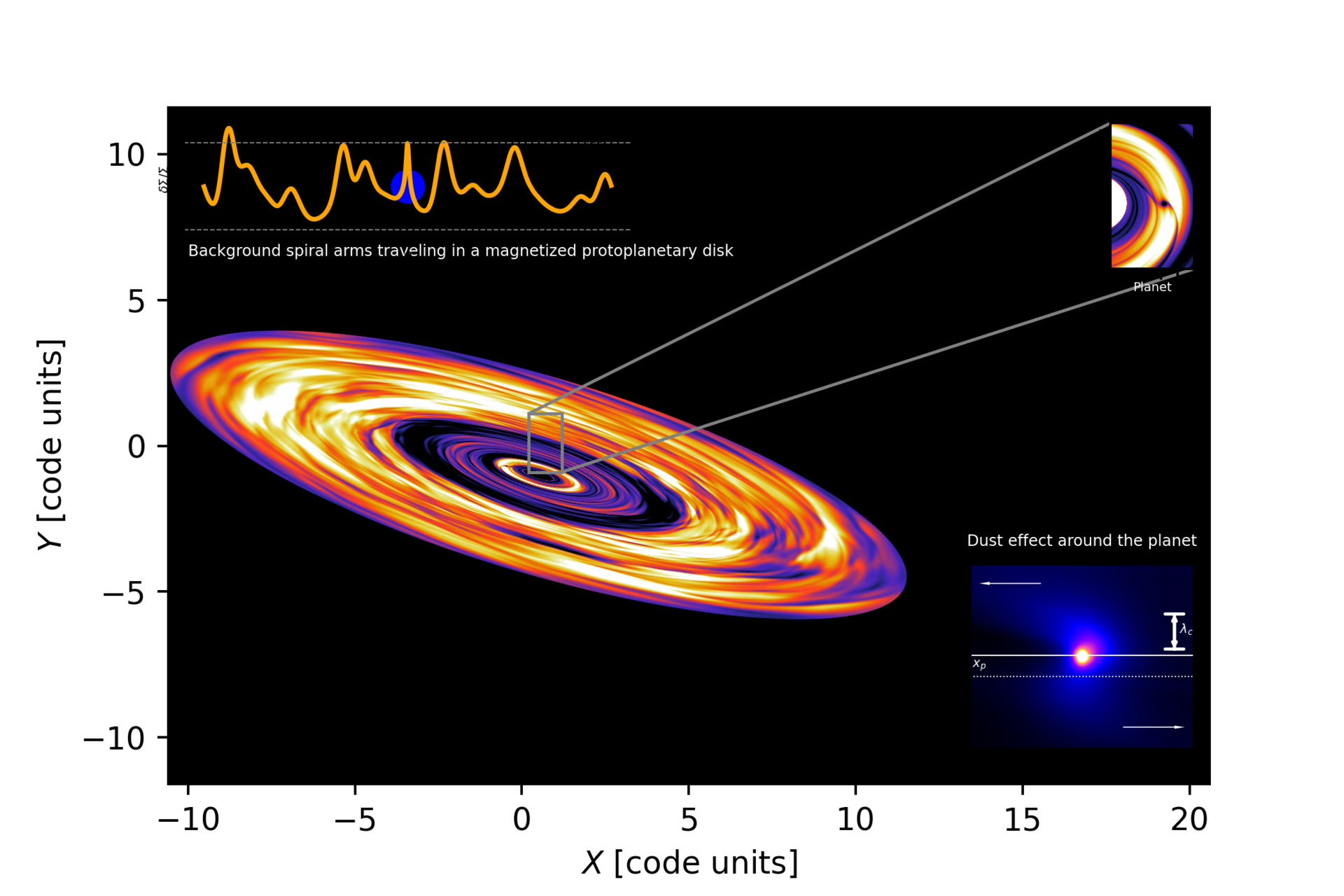
Planets are believed to be born and migrate within a disk of gas and dust which orbits a Sun-like star. Analytical and numerical models of ideal gas disks (without any extra perturbation in the gas density and without considering dust in the disk) predict a fast migration of Earth-like planets towards the central star in less time than the lifetime of the protoplanetary disk. If this really happened, the low-mass planets (including our own) should have to fall towards the central star hopelessly. However, this situation may be different when dust and density perturbations are included in the gas disk model.
The main objective of this study is to know the effect of dust on the migration of Earth-like planets embedded in gas and dust disks through three-dimensional (3D) high-resolution hydrodynamical (HD) and Magnetohydrodynamical (MHD) multifluid simulations. Our approach considering more sophisticated disk models, which may include density perturbations due to the magnetic field in the disk and gas-dust accretion from the planet, can produce new possible solutions to the rapid inward migration problem.
Stellar transits through accretion flow onto supermassive black holes
Call: 25th Open Access Grant Competition; OPEN-25-47
Researcher: Petra Suková
Institution: Astronomical Institute of the Czech Academy of Sciences
Field: Astrophysics
In the vicinity of supermassive black holes, which are found at the centres of galaxies, there may be many smaller stellar-sized objects - stars themselves, neutron stars, and smaller black holes - in addition to gas and dust. As the compact object moves, it interacts with the accretion flow and disturbs it. Since the radiation we observe from active galactic nuclei comes from extremely heated gas, changes in its motion and distribution can lead to observable effects such as periodic changes in brightness or detectable very fast outflows.
Using general relativistic magnetohydrodynamic simulations, we study the interaction between the passing object and the accreting plasma to identify typical features of such systems and to be able to detect them from the data provided by X-ray satellites.
Discontinuous Galerkin Finite Element Magneto-Hydrodynamic Simulations in Solar Atmosphere
Call: 23rd Open Access Grant Competition; OPEN-23-47
Researcher: Jan Kotek
Institution: the Czech Academy of Sciences
Field: Astrophysics
With the growing importance of electronics and satellites to humanity, the impact of solar activity on our society is increasing. Last winter, for example, SpaceX lost 40 satellites after one solar flare followed by a coronal mass ejection and a geomagnetic storm. As the sun does not fit in a lab, computer experiments are used for its research. By comparing simulation results with observations, our hypotheses can be tested. In this project, own software is used to model processes in the solar atmosphere, including simulating the reconnection of the magnetic field that leads to a solar flare. In the figure, you can also see the sections of the 3D model of the solar atmosphere above the sunspot (magnetic field lines and magnetic to plasma pressure ratio) that are used to model wave propagation. 3D simulations are computationally intensive and would be virtually impossible to perform without supercomputers and efficient methods.
HYDRODYNAMIC INTERACTIONS OF PLANETS WITH PROTOPLANETARY DISKS AND THE ORIGIN OF CLOSE-IN EXOPLANETARY SYSTEMS
Call: 21st Open Access Grant Competition
Researcher: Dr Ondřej Chrenko
Institution: Astronomical Institute of Charles University
Field: Astrophysics
Figure: Temperature of the gas at the inner rim of the protoplanetary disk (in section to the orbital plane of the disk; the whole disk can be visualized by "spinning" the image around the vertical axis).
Astronomical observations in recent years have allowed the detection of thousands of planets outside our solar system, so-called exoplanets, whose origin is shrouded in many questions. A large group of exoplanets are close-in low-mass planets (i.e. orbiting close to their host star), which typically have masses up to several Earth masses (called super-Earths or mini-Neptunes).
In this project, we will perform computational hydrodynamical simulations of the early evolution of such planets embedded in an embryonic gas-dust disk. We will study the process of planet migration, where the gravity of the structures formed in the protoplanetary disk changes the orbits of the planets.
The aim of the project is to understand under what conditions super-Earths and mini-Neptunes can migrate to the inner disk rim. To properly model the environment in which planets evolve, we need to realistically describe the physical conditions at the inner rim of the gaseous disk (see figure). The distribution of gas at the inner rim of the disk depends on the interplay of many processes, such as heating by host star radiation, magnetohydrodynamic turbulence, energy transfer by radiative diffusion, dust grain evaporation, and the associated (in)transparency of the environment.
EXPANSION OF SUPERNOVA DRIVEN SHELLS NEAR THE GALACTIC CENTER
Call: 20th Open Access Grant Competition
Researcher: Barnabas Barna
Institution: Astronomical Institute of the Czech Academy of Sciences
Field: Astrophysics
Supernova explosions are some of the most energetic events in the universe. These cataclysmic stellar deaths release chemically enriched material that expands at a high velocity into the surrounding space. The resulting bubble then sweeps around the surrounding interstellar mass, forming an envelope with a mass of several hundred suns. In doing so, it plays an important role in the generation of stars, with expanding bubbles triggering the formation of other stellar generations. Interstellar material can be transported into close proximity to the central supermassive black hole by expanding shells, thus increasing its activity. Whether this scenario is responsible for the manifestation of the supermassive black hole in the Milky Way, however, cannot be confirmed, largely due to the low activity of this nearest supermassive black hole. Simulating the development of shells and the influence of initial and marginal conditions requires numerical methods. Barnabas Barna and his collaborators plan to use the awarded core hours for hydrodynamic simulations with FLASH code in 3D. The objective is to explore the interaction of an interstellar environment with an expanding shell. The results will be matched with current observations: e.g., the current distribution of supernova remnants will be compared to powerful X-ray flashes from the past.
PLANET FORMATION AFTER PEBBLE ISOLATION
Call: 18th Open Access Grant Competition
Researcher: Dr Ondřej Chrenko
Institution: Astronomical Institute of Charles University in Prague
Field: Astrophysics
Ondřej Chrenko was awarded more than 600,000 core hours for his project focused on planet formation processes. Modern scenarios of planet formation suggest that planets form by accretion of cm to m-sized solid particles, the dynamics of which is subject to the aerodynamic drag in the surrounding protoplanetary disk. The drag not only causes a radial drift of pebbles through the disk but also enhances the efficiency of the gravitational capture of pebbles by a planetary embryo. However, once the mass of a growing protoplanet exceeds a certain threshold, a pressure bump is formed in the gas outside the planetary orbit where pebbles start to accrete, and the protoplanet growth ceases. The objective of this project is to investigate the evolution of pebbles, which gradually accumulate in the pressure bump. Ondřej Chrenko will use the IT4Innovations supercomputers for 2D and 3D simulations of a two-fluid flow (solid-togas) system in order to verify if hydrodynamic instabilities occur in the pressure bump. These instabilities might cause pebbles to become concentrated into clumps, which might undergo a gravitational collapse, thus forming a new planetary embryo. Using local, high-resolution simulations, the project team will study whether hydrodynamic instabilities, such as those in the figure on the right (Comment: the figure on the right is borrowed from a paper by Benítez-Llambay et al. 2019), may occur in the pressure bump.
IMPACT OF MASSIVE STARS ON THE COMPOSITION OF GLOBULAR CLUSTERS
Call: 18th Open Access Grant Competition
Researcher: Dr Michail Kourniotis
Institution: Astronomical Institute of the CAS
Field: Astrophysics
Michalis Kourniotis from the Astronomical Institute of the CAS was awarded 718,000 core hours to study the impact of massive stars on the composition of globular clusters. With a diameter of tens of light years, globular clusters are spheroidal dense collections of hundreds of thousands to millions of very old stars. They can typically be found in the spheroidal halo of the Milky Way and other galaxies. Originally thought to comprise of stars of the same age, it is now well established that globular clusters host multiple generations of stars with different ages and chemical compositions. Numerical methods for simulating the non-stationary wind of massive clusters are valuable for acquiring knowledge about gas dynamics inside a small globular cluster and thermal instabilities that potentially lead to newborn stars, in particular. The latest stellar evolutionary models provide essential input parameters to determine the mass and energy accumulated in globular clusters by massive stars in the form of extremely fast stellar winds and supernovae outbursts. Michail Kourniotis with his colleagues Richard Wünsch and Barnabás Barna will use the supercomputer to perform high-resolution 3D simulations to obtain information about formation of several stellar generations in spheroidal globular clusters. In addition, the objective of this project is also to study the impacts of extreme stellar types on the wind evolution in globular clusters and its spatial distribution.
FORMATION OF PLANETARY SYSTEMS
Call: 13th Open Access Grant Competition
Researcher: Dr Ondřej Chrenko
Institution: Charles University
Field: Astrophysics
Can life be created on planets discovered outside our solar system (on exoplanets)? One of the key steps to find the answer to this question is understanding how exoplanets and their systems are formed. Possible scenarios for planetary system formation will be researched by Dr Ondřej Chrenko from Charles University in Prague. In this research project, he collaborates with other Czech astronomers Doc. Miroslav Brož and Dr David Nesvorný (working in the USA) as well as with Lund Observatory in Sweden. Using computer simulations generated by the IT4Innovations supercomputers, this project aims at researching formation of planetary embryos and their dynamic development in protoplanetary disks of dense gas and dust rotating around young newly formed stars.

